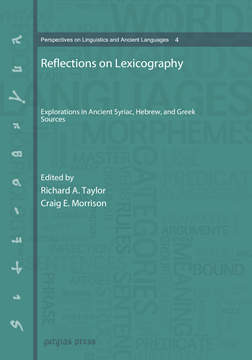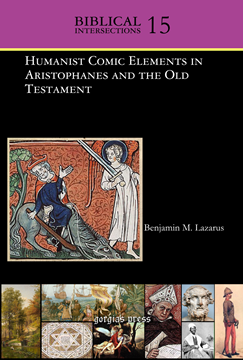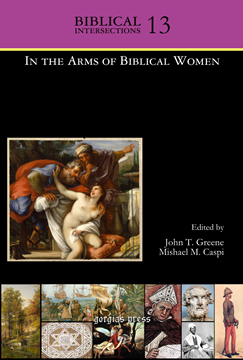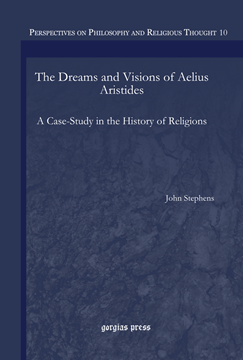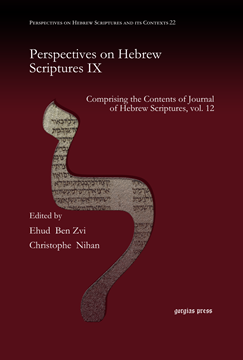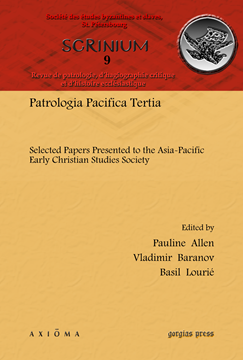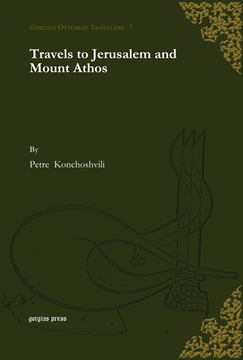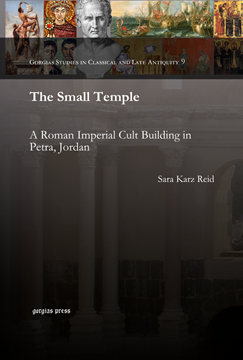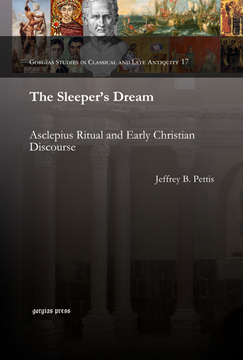Reflections on Lexicography
Explorations in Ancient Syriac, Hebrew, and Greek Sources
Edited by Richard A. Taylor & Craig E. Morrison
ISBN: 978-1-4632-0229-3
Colloquia of the International Syriac Language Project. These essays offer a probing analysis of selected lexical tools and methods for working with ancient Syriac, Hebrew, and Greek sources, as well as offering reflections on methodological concerns for lexicographical tools of the future.
$183.00 (USD) $109.80 (USD)
Humanist Comic Elements in Aristophanes and the Old Testament
Series: Biblical Intersections 15
ISBN: 978-1-4632-0243-9
Lazarus compares and discusses comic elements used for didactic purposes in two separate literary traditions: Old Testament narrative and Aristophanic Comedies. Given that humour relies on taking people's ideas of what is normal and making them incongruous, this volume examines these very different texts to see how they use that comic incongruity to help define what it means to be human within the hierarchy of the universe.
$192.00 (USD) $115.20 (USD)
In the Arms of Biblical Women
Edited by John T. Greene & Mishael M. Caspi
Series: Biblical Intersections 13
ISBN: 978-1-4632-0231-6
The less-discussed character in the Bible is the woman: two talking animals therein have sometimes received more page space. This volume shines the light of close scrutiny in the less-trodden direction and focuses on biblical and allied women, or on the feminine side of Creation. Biblical women are compared to mythical characters from the wider Middle East or from contemporary literature, and feminist/womanist perspectives are discussed alongside traditional and theological perspectives.
$168.00 (USD) $100.80 (USD)
The Dreams and Visions of Aelius Aristides
A Case-Study in the History of Religions
ISBN: 978-1-4632-0232-3
An analysis of the religious experiences of the Greco-Roman sophist, Aelius Aristides. As a member of the cult of Asclepius, Aristides recorded his nocturnal dreams, waking visions and spiritual healings in a diary entitled the Sacred Tales. A study of this diary sheds light on the spiritual environment of the Roman world in the first and second century CE.
$125.00 (USD) $75.00 (USD)
Perspectives on Hebrew Scriptures IX
Comprising the Contents of Journal of Hebrew Scriptures, vol. 12
Edited by Ehud Ben Zvi & Christophe Nihan
ISBN: 978-1-4632-0420-4
This volume incorporates all the articles and reviews published in volume 12 (2012) of the Journal of Hebrew Scriptures.
$287.00 (USD) $172.20 (USD)
Patrologia Pacifica Tertia
Selected Papers Presented to the Asia-Pacific Early Christian Studies Society
ISBN: 978-1-61143-919-9
This volume collects selected papers from the seventh annual conference of the Asia-Pacific Early Christian Studies Society (APECSS), held in Seoul, Korea on 5–7th July 2012, on the theme "Preaching and Ministry in Early Christianity".
$199.00 (USD) $119.40 (USD)
Travels to Jerusalem and Mount Athos
Series: Gorgias Ottoman Travelers 3
ISBN: 978-1-4632-0418-1
An account by Archpriest Petre Konchoshvili of his travels to Jerusalem and Mount Athos in 1899, dealing with the relations between the Georgians, Greeks and Russians in the Holy Land.
$147.00 (USD) $88.20 (USD)
The Small Temple
A Roman Imperial Cult Building in Petra, Jordan
ISBN: 978-1-4632-0234-7
Excavation of the Small Temple of Petra, Jordan has revealed a Roman building likely dedicated to the imperial cult. Constructed in the wake of Roman annexation of Nabataea in 106 CE, the temple would have helped to solidify Roman control. Reid systematically examines the evidence used to support the identification of the Small Temple as an imperial cult building through the discussion of its prominent use of marble, a material with Roman imperial associations and almost entirely monopolized by the bureaucracy of the Roman Empire. The analysis of architectural evidence, as well as the placement of the Small Temple within the city, also support this identification.
$146.00 (USD) $87.60 (USD)
The History, Poetry, and Genealogy of the Yemen
The Akhbar of Abid b. Sharya Al-Jurhumi
Series: Gorgias Islamic Studies 3
ISBN: 978-1-59333-394-2
The History, Poetry, and Genealogy of the Yemen is the earliest known history of pre-Islamic Yemen. Attributed to the South Arabian historian ‘Abid b. Sharya al-Jurhumi, it recounts in prose and poetry six saga cycles of ancient personages and events of the Yemen. Here, two sagas, the dispersion of Sam’s descendants from Babel to the Yemen, and the destruction of the tribes of ‘Ad and Thamud, are translated with complete annotation. The tales of Luqman b. ‘Ad and his seven vultures, Sulayman and Bilqis, the Himyarite kings, and Tasm and Jadis are given in full synopses.
$184.00 (USD) $110.40 (USD)
The Sleeper's Dream
Asclepius Ritual and Early Christian Discourse
ISBN: 978-1-4632-0256-9
This analysis probes into the nature and use of bodily healing and dreams in antiquity, examining literary and archaeological evidence in order to gain a sense of how the Greco-Roman world understood each through the Asclepius cult, and to understand references to bodily healings and dreams by early Christian cults and groups.
$145.00 (USD) $87.00 (USD)
